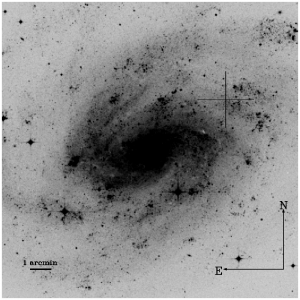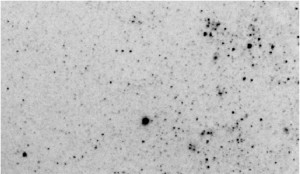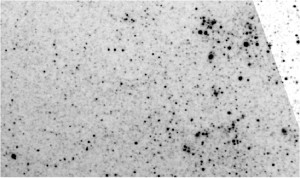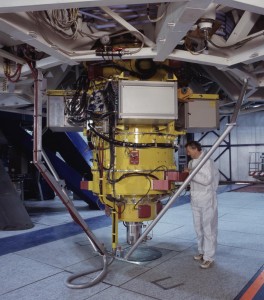A bright optical transient in NGC300 or “how to put and end to a nice vacation”

Bringing the enthusiasm for astronomy to kids
November 16, 2009
The Crime of Galileo
November 18, 2009
The nearby galaxy NGC300 (Digital Sky Survey). The position of the optical transient is marked by a cross.
Last year, while spending a nicely warm morning in Northern Italy, I got a phone call from Avik Harutyunyan, a post-doc working in La Palma at the Italian National Telescope “Galileo”. He was quite excited. The discovery of a bright optical transient in the nearby galaxy NGC300 had just been announced in one of the electronic telegrams issued by CBAT. The word “optical transient” is normally used to indicate a new source, whose nature is yet unknown. In these last years the interest for these transients has been steadily growing, because it looks like there is a class of objects that could fill the so called “gap” between the tremendously powerful Supernova explosions and the more discrete fireworks of Novae. Much more on these new beasts will be found by Panstarrs, Sky Mapper and the Palomar Transient Factory.
Andrea Pastorello and his colleagues in Belfast are working hard on this topic and, when I can, I collaborate with them. Actually, this is why Avik called me. In the last years I have been getting deeper and deeper into polarimetry, a technique that can give you information about the geometry of the object you are observing. For doing that, you “just” need a big telescope, because the technique is “photon starving”, which means that at a “small” telescope (say of a few meters), it would take ages to get enough signal on your detector.
Once more I said to myself that I had chosen the wrong astrophysical field… I have been working on supernovae for more than 15 years now, but I hate them! They always blow up during week-ends and vacation time %(*&$!$@#! (Note that Shri Kulkarni, one of the bosses of transients, uses to say that supernovae are for the lazy people. I hate Shri too…). The bottom line is that in the next few days we put together a proposal for ESO’s Director General Discretionary Time, to get some time at the Very Large Telescope. The idea was to obtain spectropolarimetry on two different epochs (plus a high resolution spectrum to get detailed information on the velocity structure of the ejected material). As you can imagine, the optical transient in NGC300 became the target of a number of campaigns around the world (a number of papers have already appeared on this object). But the polarimetric capabilities of the VLT are quite unique and this, coupled to its large diameter (8.2m), put us in a privileged position. The proposal went through and the observations were successfully carried out at the beginning of July.

The optical transient in NGC300 (try to find it yourself). The image was taken with VLT-FORS1 as part of our observations.
That was the “easy” part. I spent the following months analyzing the data and trying to make sense of them. At some point I felt I had reached a dead end and I decided to abandon the project for a while (sometimes thinking about other topics helps to find the solution, or at least a different way of looking into the problem). I could do this because I was almost sure no competing team had this kind of data. This is often not the case, and it helped a lot. Last spring I went back to the data, I discussed a lot with other people working in the field and, in the end, I came up with a solution. What the data were telling us is that there were two components that contributed to the signal: an interstellar one, having nothing to do with the outbursting source, and a circumstellar one, possibly related to the progenitor star. And this one was strongly asymmetric, suggesting that the star had undergone one or more episodes of asymmetric mass loss. Polarimetry had done its job and there was enough meat to write a paper. Which I did in the next few months, managing to submit it to Astronomy and Astrophysics just before going on summer vacations.
The big discussion about these transients (there was another one, very similar to OT-NGC300, in 2008) is whether they are real explosions or just the superficial outburst of some exotic, very luminous, variable star. This was one of the many topics discussed at the Stellar Death Conference in Santa Barbara – CA. In one of my next posts I will talk about it, probably the best SN conference I have ever attended. Although it was “disturbed” by the discovery of the SN of the year, dubbed SN2009ig. While all young post-docs and students were spending the evenings in a nice jacuzzi, I was triggering new observations and reducing data with my laptop in my room.
I hate Supernovae!! Sooner or later I will switch to the most quiet objects in the universe. Oh, those good old times of Aristotle, when the Universe was unchanging.
When I got back from holidays I had a nice surprise. The paper had been accepted for publication in A&A. If you wish to see how it looks like, just click here.
You may wonder why I post this today. Well, I am going through the manuscript proofs readings, which is the most boring part of the whole process and I though I needed some short distraction.


